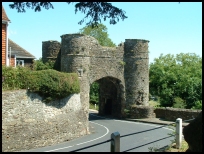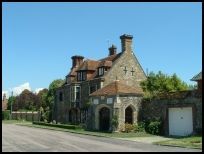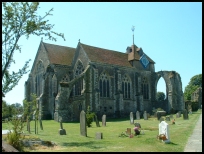|
| |
 Winchelsea in East Sussex is located 2 miles to the South West of Rye on the A259. Winchelsea in East Sussex is located 2 miles to the South West of Rye on the A259.
Before the Norman conquest it used to have its own mint, and became
a port of considerable importance in the 11th century. However in 1250
it was partially submerged by the sea. Sixteen years later in 1266
it was sacked by Prince Edward, in order to put an end to the
indiscriminate piracy rife amongst Winchelsea's seamen. Then in
1287 a Great Storm destroyed Old Winchelsea and the townsfolk who
survived moved to the present location.
A new town was built by Edward I, designed on the grid system, and with it's
tidal harbour on the river Brede , Winchelsea became a member of
the Cinque Ports Federation, providing ships for the defence of
the country. Although not one of the Cinque ports, Winchelsea was
an 'Antient Town' affiliated to the Cinque ports, similar to Rye .
The Black Death of 1348 took its toll on the town, and it is believed
that the dead were buried in a large, circular, tree covered
mound in the open fields on the south end of town close to the
New Gate. This site, ( which, incidentally, is as far from the
inhabited area as it is possible to get and still be on the hill
- not a trivial consideration for a mass grave!) has always been
known to local folk as 'The Plague Pit'. Of course, there is no
proof that it was the burying place for Plague victims but it
is clearly man-made, and is at least a credible location. (Many thanks to Dr R.E.Turner for this detail)
In the 14th and 15th centuries the French attacked and plundered
Winchelsea seven times , devastating the place, and reducing the
population over the years from 6,000 to only a few hundred.
Deadmans lane provided a location to bury the dead from the French raids.
At that time, St Giles Church stood above this deep track down
to the shoreline. The French, breaking into the town, caught many
people at mass in the church on Sunday (although I wonder if they
were not merely seeking sanctuary there) and slaughtered them,
tossing many of the bodies down into the lane. They were found
there after the French had vacated the sacked and burned town
and the survivors crept back to face the devastation. (Many thanks to Dr R.E.Turner for this detail)
Gradually the sea retreated, the harbour silted up, and then the
once proud port was marooned.
In 1539 the harbour was looked on as important by King Henry VIII and
the small defensive fort of Camber Castle was expanded to provide cover to
the harbour in the Camber(Chambre) between present Camber , East Guldeford ,
Rye and Winchelsea. The fort became obsolete by 1637 as the
Camber had silted so badly.
On the 7th October 1790, that great apostle of the 18th century,
John Wesley, preached his last open-air sermon under the great
ash tree. Wesley's ash tree was uprooted in 1927, but another
was planted to replace it. This stands on the west side of the
churchyard of St Thomas's church. This was a glorious building,
which suffered much like the rest of the town.
Across the road from the churchyard stands the Great Hall. One
of Winchelsea's oldest buildings, the lower floor was once the
gaol. The first floor is now the museum, full of relics of
the history of Winchelsea , and a model of the town before the French
destroyed it.
Winchelsea is the smallest town in the country to have its own
Mayor, and boards in the museum list all the Mayors back to Gervase
Alard in 1295.
Famous people who lived in Winchelsea are commemorated by plaques
on the walls of the houses. Amongst them are the famous writers,
Thackeray and Joseph Conrad. Ellen Terry the great actress whose
museum is at Smallhythe , lived in a cottage beside the Strand
Gate - one of the three medieval entries into the town. The
Victorian artist Millais painted his famous portrait, 'The Blind
Girl', down on the marshes, with Winchelsea on its hilltop in
the background.
Finally the much loved comedian, author and TV personality
Spike Milligan famous for the Goon Show is buried in the churchyard. |
|
 There are many views in Winchelsea in East Sussex , walk to the sea gate, and look out over
the seaside village of Winchelsea Beach to the English Channel. There are many views in Winchelsea in East Sussex , walk to the sea gate, and look out over
the seaside village of Winchelsea Beach to the English Channel.
The town has many beautiful buildings, and just walking around is a delight.
There are so many pretty places to see, that you should spend an hour
or two just exploring this peaceful town. The 1066 Country Walk runs through the village. |
|
 The main A259 passes along one edge of the town, and this
road gets very busy in the summer tourist season, however
the main part of the town is quite peaceful. The main A259 passes along one edge of the town, and this
road gets very busy in the summer tourist season, however
the main part of the town is quite peaceful.
Winchelsea in East Sussex is a very small town with only a few shops which
include the award winning Tea Tree Tea Rooms a member of
the Tea Council Guild of Tea Shops, just the place for
lunch or a refreshing cup of tea. The limited services
available in the town are more than made up for by its beauty.
The Hastings to Rye hourly bus route passes through the town.
There is a station just outside the town on the Ashford to Hastings
line, with an hourly service during the day, and more frequently
during rush hour.
The main shopping centres are Rye about 2 miles East, or Hastings
about 9 miles West. |
|
| Winchelsea is shown as the red symbol on the map. |
|
|
Nearby Villages
(click on symbol to see the village page) |
| Village= | |
Town= | |
Recorded in Domesday= |  |
| |
|
|
Brede |
(Edward I inspects the Channel Fleet) | | 4.98 miles |
|
|
Broad Oak Brede |
(On the Crossroads) | | 5.17 miles |
|
|
Broomhill |
(Swept away by the Storm) | | 4.61 miles |
|
|
Camber |
(Sands and Holidays) | | 3.84 miles |
|
|
East Guldeford |
(Barn-like Church) | | 3.10 miles |
|
|
Fairlight |
(Firehills and Views) | | 3.99 miles |
|
|
Guestling |
(Changing guards at Buckingham Palace) | | 3.78 miles |
|
|
Hastings East Cliff |
(Beautiful Views and peaceful Walks) | | 5.75 miles |
|
|
Hastings Ore |
(Iron and the Turnpike) | | 5.86 miles |
|
|
Icklesham |
(Paul McCartney's Recording Studio) | | 1.74 miles |
|
|
Iden |
(Sheriff of Kent and Jack Cade) | | 4.12 miles |
|
|
Old Winchelsea |
(Abandoned after the Great Storm) | | 0.71 miles |
|
|
Peasmarsh |
(Black Death moves village) | | 3.95 miles |
|
|
Pett |
(End of the Royal Military Canal) | | 2.88 miles |
|
|
Playden |
(Saltcote and fish) | | 3.76 miles |
|
|
Rye |
(On the Island) | | 2.11 miles |
|
|
Rye Harbour |
(Nature Reserve and unspoilt beaches) | | 2.48 miles |
|
|
Udimore |
(Angels move the Church) | | 2.88 miles |
|
|
Westfield |
(Bonfire Boys under suspicion) | | 6.11 miles |
|
|
Winchelsea Beach |
(Holidaymakers and Henry VIIIs Fort) | | 0.85 miles |
|
|